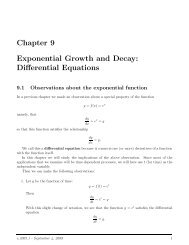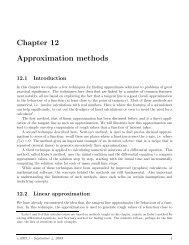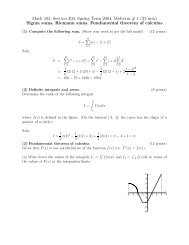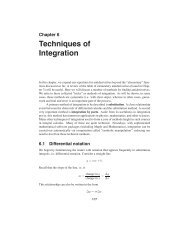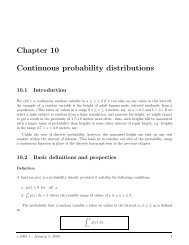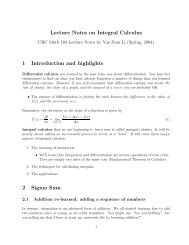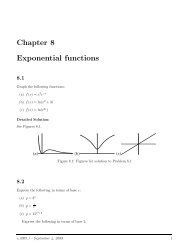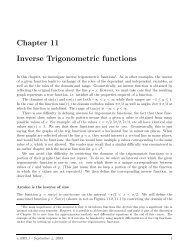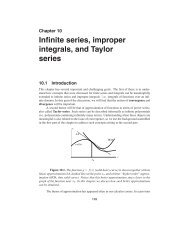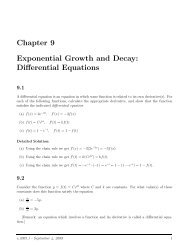Chapter 10 Trigonometric functions - Ugrad.math.ubc.ca
Chapter 10 Trigonometric functions - Ugrad.math.ubc.ca
Chapter 10 Trigonometric functions - Ugrad.math.ubc.ca
You also want an ePaper? Increase the reach of your titles
YUMPU automatically turns print PDFs into web optimized ePapers that Google loves.
Math <strong>10</strong>2 Notes <strong>Chapter</strong> <strong>10</strong><br />
1<br />
1<br />
1<br />
0.8<br />
0.8<br />
0.5<br />
0.6<br />
0.6<br />
z<br />
z<br />
–3 –2 –1 0 1 2 3<br />
x<br />
0.4<br />
0.4<br />
–0.5<br />
0.2<br />
0.2<br />
–1 –0.8 –0.6 –0.4 –0.2 0 0.2 0.4 0.6 0.8 1 –0.2 –0.1 0<br />
0.1 0.2<br />
–1<br />
x<br />
x<br />
Figure <strong>10</strong>.11: Zooming in on the graph of y = cos(x) at x = 0<br />
f ′ f(x + h) − f(x)<br />
(x) = lim<br />
h→0 h<br />
d sin(x) sin(x + h) − sin(x)<br />
= lim<br />
dx h→0 h<br />
sin(x) cos(h) + sin(h) cos(x) − sin(x)<br />
= lim<br />
h→0<br />
(<br />
h<br />
= lim sin(x) cos(h) − 1 + cos(x) sin(h) )<br />
h→0 h<br />
h<br />
( ) ( )<br />
cos(h) − 1<br />
sin(h)<br />
= sin(x) lim + cos(x) lim<br />
h→0 h<br />
h→0 h<br />
= cos(x) (<strong>10</strong>.1)<br />
Observe that the limits described in the preceding section were used in getting to our final result.<br />
A similar <strong>ca</strong>lculation using the function cos(x) leads to the result<br />
d cos(x)<br />
dx<br />
= − sin(x).<br />
(The same two limits appear in this <strong>ca</strong>lculation as well.)<br />
We <strong>ca</strong>n now <strong>ca</strong>lculate the derivative of the any of the other trigonometric <strong>functions</strong> using the<br />
quotient rule. For example, let us consider the derivative of y = tan(x):<br />
v.2005.1 - September 4, 2009 14



